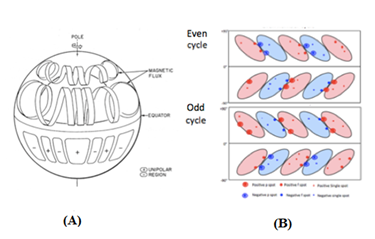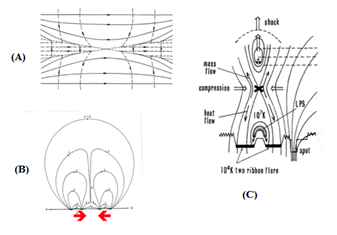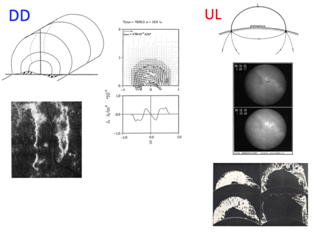eISSN: 2576-4543


Review Article Volume 2 Issue 4
International Arctic Research Center, University of Alaska Fairbanks, Alaska, USA
Correspondence: Syun Ichi Akasofu, International Arctic Research Center, University of Alaska Fairbanks, PO Box?757340 930, Koyukuk Dr. 415, Akasofu bldg Fairbanks, Alaska 99775?7340, USA, Tel 9074 7460 12
Received: July 20, 2018 | Published: July 27, 2018
Citation: Akasofu SI. Three major paradigms in solar physics. Phys Astron Int J. 2018;2(4):336?339. DOI: 10.15406/paij.2018.02.00107
There are three major paradigms in the field of solar activity research. They are:
Practically all researches of solar activities during several decades have been based on the above paradigms. Although these three paradigms have been almost universally accepted since the1960s (as many papers state so in their introduction), it may be worthwhile to review them. It is shown that: (i) Unipolar magnetic regions are different from old active regions and are actually one of the fundamental features of the solar internal dynamo process. (ii) A positive single spot is produced by a coalescence process in a positive unipolar magnetic region (vice versa), and a pair of positive and negative spots occurs at the boundary of two unipolar magnetic regions (of the opposite polarity) by a p–spot inducing a f–spot. (iii) Solar flares are powered by the photospheric dynamo process, and their explosive feature is caused by a sudden disruption of the current loop around the region where the dynamo process is in progress. These are examples of an alternative idea for each of the three paradigms and are presented to promote new thinking.
Keywords: unipolar magnetic regions, sunspots, solar flares
In any scientific field, there are periods during which there is a high degree of agreement, both on theoretical assumptions and on the problems to be solved within the framework provided by those assumptions. The resulting coherent scientific research is called a paradigm. Solar physics is no exception. There are three major paradigms in the field of solar activities. In this paper, we examine each of them and consider a possible alternative.
It has been known that there are large–scale unipolar magnetic fields distributed on the photosphere. They have been described as “large–scale fields”.1 Based on a study of the developments of the solar cycle by Leighton2, unipolar magnetic regions have been considered as remnants of old active regions. However, a detailed examination of their development during the sunspot cycle shows that they are likely to be one of the most fundamental elements of solar magnetism.3 His conclusion is based on the two findings and others:
Thus, it is suggested that the unipolar magnetic regions should be distinguished from old active regions and that they are one of the fundamental elements in solar magnetism. Nakagawa4 considered the formation of unipolar regions in his internal dynamo theory (Figure 1A). Unipolar magnetic regions are shown also schematically in Figure 1B in connection with single spots and pairs of spots (Section 3).
Babcock6 considered that a pair of sunspots are formed when a thin magnetic flux tube rises above the photospheric surface. However, there have been three long–standing problems, which have been left out for a long time. They are:
Although they have become the additional problems, they happen to become keys to consider the five problems together.3 Figure 1B illustrates the phenomenology of both the unipolar magnetic regions and the formation of single and pair of spots.5

Figure 1 (A) The solar dynamo model, showing magnetic fluxes in the northern hemisphere. Its photospheric fields are shown as unipolar magnetic field regions; Nakagawa4. (B) Assembly of the available information regarding, single spots, sunspot pairs and their relationship among positive (red) and negative (blue) unipolar magnetic regions, for both even and odd cycles.5 Other known facts, such are the reversal of the polarity with respect the equator and sunspot cycle are also included.
The problem (4) suggests that positive single spots could form as a result of coalescence in a positive unipolar region (vice versa); the problem (1) is explainable in this way (Figure 1B). Further, because of (4), it is obvious that a pair of spots is formed at the boundary of two unipolar magnetic regions, positive spots in a positive unipolar region and negative spots; the problem (5) is explainable in this way. Further, there is a possibility that p–spot induces a f–spot across the boundary, if two unipolar regions (of the opposite polarity) is connected by magnetic field lines. If so, the problems (2) and (3) are explainable as discussed below.
Figure 2 shows the formation of pores and small single spots at the boundaries of the convection cells by the irregularities of the convection cells and the subsequent coalescence, negative pores and small spots (blue) in a negative unipolar region and positive pores and small spots (red) in a positive unipolar region. At the boundary of two unipolar regions, one can see many U–shaped half–cells (lying horizontally), namely negative half–cells and positive half–cells. In each half–cell, it has been observed that pores and small spots tend to coalesce and form larger spots. When two U–shaped cells of the opposite polarity combine across the boundary by the induction effect, they form a pair of spots along an elliptically shaped boundary. McIntosh1 showed that this the way by which a pair of spots is formed. This is the reason why pairs of spots tend to appear near the boundary of two unipolar regions, not in the middle of unipolar regions; according to Babcock’s model, pairs of spots can occur randomly.

Figure 2(A) Part of Figure 1B. (B) An enlarged part of Figure 1B at the boundary of two unipolar regions. It shows two U–shaped convection cells of opposite polarity, together with pores and small spots in each U–shaped region. (C) When they combine across the boundary, they form an elliptically shaped sunspot pair.
As mentioned in the above, there is a possibility that p–spot (or p–U–shaped region induces f–spot (or f–U–shaped region) across the boundary by Alfven waves along magnetic field lines. The induction will allow us to consider the delay of f–spot. Further, the induction does not have to produce the identical f–spot of the opposite polarity, because the magnetic field distribution is not identical across the boundary; this allows us to consider the unbalance of the magnetic flux of p–and f–spots. Since the problems (2) and (3) are contradictory to Babcock’s theory, there is no room to consider them; for details of the description of this considerations.3 It may be noted that our description here is based on the observed features, not hypotheses below the photospheric surface, which we cannot prove.
It has long been considered that a huge amount of energy can rapidly be released by magnetic reconnection of an ant–parallel configuration of magnetic field;7 Figure 3A. Much of efforts in studying solar flares during the last few decades, both theoretical and observational, has been concentrated in advancing theories of magnetic reconnection, namely how rapidly magnetic energy could be extracted from an anti–parallel magnetic configuration. Sweet8 was the first to suggest that an anti–parallel magnetic field configuration can provide magnetic energy for solar flares by suggesting that such an anti–parallel magnetic field configuration can be formed, if two sunspot pairs collide (Figure 3B), which is a dynamo process; see below.

Figure 3 (A) An anti–parallel magnetic configuration.9 (B) The formation of an anti–parallel magnetic configuration, when two sunspot pairs collide.8 (C) Coronal model of solar flares proposed by Hirayama10; magnetic reconnection is supposed to occurs above a magnetic arcade, as indicated by the X–line.
However, there are a number of both theoretical and observational problems on magnetic reconnection, but they are probably not considered because they do not agree with the reconnection theories. Some of them are:
There is an interesting observation of a flare, which is related to the issue (a). Figure 4A shows the flare on the photosphere/chromosphere as seen by the Hα emission, but the simultaneous image in the corona shows no indication of the X–line formation above a magnetic arcade (Figure 4B).

Figure 4 Observations of a flare: (A) A flare is progress in the photosphere/chromosphere, (B) but the simultaneous coronal observation does not show the X–line (Courtesy of A. Title).
If all formations of the X–line are supposed to be associated with magnetic reconnection (energy release), Sheeley et al.’s observation11 and Figure 4 are very puzzling. This puzzle may be explainable by considering (a), (b), (c) and (d) altogether. It is suggested that the linkage of the field lines (the X–line formation) is not much associated with the energy release, when there is little resistive dissipation and that term ‘reconnection’ should be used only when the linkage is associated with significant energy release (if any). It is likely that the apparent relation between the linkage and flares is caused by the fact that some other processes are also in progress; an example is the dynamo process (the sunspot collision by Sweet8.
In the following, it is suggested that a current loop circuit around flare regions is responsible for providing the magnetic energy. Alfven & Carlqvist14 suggested that flares is caused when the current loop circuit is suddenly disrupted, releasing the magnetic energy in the current loop, enhancing also the Hα emission; the magnetic energy in the flare loop circuit(whereand L=2000H) and the voltage (dt= one hour); this high voltage may be the only way to produce solar sub–cosmic ray particle.
In this respect, it is important to realize that solar flares are various manifestations of electromagnetic energy dissipations. Therefore, solar flares should be discussed as a chain of processes, which consist of a dynamo as their power supply, currents/circuits (power transfer) and dissipations (solar flares).
In considering solar flares in terms of the chain of processes, it is essential to divide observed phenomena into two, the directly driven component (DD) by the photospheric dynamo and the unloading component (UL), which is due to release of the accumulated energy produced by the dynamo. It is suggested that the phenomenon caused by the DD process is spotless flares, which have not got much attention these days. As mentioned earlier, there is not enough magnetic energy above magnetic arcade to produce spotless flares. Thus, the photospheric dynamo is the only process, which can supply directly the power/energy; the power P of the photospheric dynamo=V(B2/8π)S = 2.0x 1026 erg/s= W [the minimum energy1030 ergs ÷ one hour], V=1 km/s, B=100G, S [the front cross–section, the lateral length= 5x104 km, depth 1000 km]); the collision of two pairs of spots by Sweet8 correspond to this as well. In Figure 5, the dynamo process and a spotless flare are shown as the DD component.

Figure 5 DD: The dynamo process proposed by Choe & Lee16and a spotless flare. UL: The current loop suggested by Alfven & Carlqvist15, an example of a sudden disappearance of a dark filament (The Hidaka Observatory) and the expanding prominence (Courtesy of W.O. Roberts); the expanding filament is seen as an upward moving prominence.
It is also suggested that the phenomenon caused by the UL process is a sudden disappearance of a dark filament along the two–ribbon Hα emission. In the past, this phenomenon was called “disparitions brusque, DB”,15 but has also not got much attention in recent years. However, some of such a dark filament constitutes a part of current loop, which has enough magnetic energy as shown in the above.
It is important to note that when solar flares are a product of the chain process, the quantity (DD+UL) should be, wheredenotes the dissipation rate.
The purpose is this paper is to demonstrate that different ideas should be promoted in each of the three paradigms, in spite of the fact that they have been almost universally accepted. As shown in this paper, when each paradigm is examined, it has theoretical or observational problems or contradictions, but has generally been considered to be eventually being solved or trivial. Some of the problems are pointed out in each of the three paradigms. It is shown that these problems cannot be overcome without considering new thoughts. An example of alternatives is summarized in the abstract, (i), (ii) and (iii). The alternatives suggested in this paper are not obviously be qualified as new paradigms, but it is hoped they will be useful in stimulating new thinking toward a new paradigm in each subject.
The author would like to thank Dr. A.Title for providing us a video of his coronal observations and Dr. Hiei for a set of flare images at the Hidaka Observatory. He thanks also Dr. Lou–Chang Lee for his discussion of solar flares.
Author declares there is no conflict of interest.

©2018 Akasofu. This is an open access article distributed under the terms of the, which permits unrestricted use, distribution, and build upon your work non-commercially.